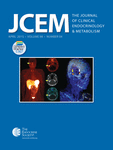JCEM:肢端肥大症的生长激素分泌仍受中枢调控
2013-05-20 JCEM 丁香园
传统观点上,指端肥大症被视为由自主性垂体生长激素瘤分泌过多生长激素(GH)引起的一种疾病。为了检验肢端肥大症的生长激素分泌是否仍受正常下丘脑调控,研究正常对照者和新诊断、未治疗的肢端肥大症患者生长激素的昼夜节律性,来自美国密歇根大学的Ariel L Barkan博士及其团队进行了一项研究,该研究发现,多个未经治疗肢端肥大症患者的生长激素谱分析,揭示生长激素中枢调控的标志持续存在,例如昼夜节律性、性
传统观点上,指端肥大症被视为由自主性垂体生长激素瘤分泌过多生长激素(GH)引起的一种疾病。为了检验肢端肥大症的生长激素分泌是否仍受正常下丘脑调控,研究正常对照者和新诊断、未治疗的肢端肥大症患者生长激素的昼夜节律性,来自美国密歇根大学的Ariel L Barkan博士及其团队进行了一项研究,该研究发现,多个未经治疗肢端肥大症患者的生长激素谱分析,揭示生长激素中枢调控的标志持续存在,例如昼夜节律性、性别二态性、以及年龄相关生长激素输出下降。该研究结果在线发表在2013年5月2日的美国《临床内分泌代谢杂志》(The journal of clinical endocrinology &metabolism)上。
该研究是在密歇根大学临床研究中心进行的住院患者观察性研究。包括104例正常对照者和67例肢端肥大症患者。干预措施包括超过24小时的频繁采血取样。主要观察指标是肢端肥大症患者是否与正常对症组相似,生长激素分泌表现出节律性、性别二态性、以及年龄相关生长激素分泌下降。
该研究结果发现,正常对照组和指端肥大症患者3个主要生长激素波的最高值出现在12:00pm、5:00pm和1:00am(所有P<0.001)。不论性别,对照组和肢端肥大症患者都显示出一个清晰的夜间生长激素波的出现(所有P<0.001)。生长激素分泌波的最高振幅(夜间,1:00am)与生长激素分泌最低点(9:00am)相比较,在2组间明显不同,肢端肥大症患者有明显较低的数量级(P<0.001)。随后两组的亚组分析分别在两种性别进行。与整个群组相似,不论性别,对照组和肢端肥大症患者都显示出一个清晰的夜间生长激素波的出现(所有P<0.001)。与对照组相似,生长激素波明显抬高的患者显示一个年龄相关的生长激素分泌下降。
该研究发现,多个未经治疗肢端肥大症患者的生长激素谱分析,揭示生长激素中枢调控的标志持续存在,例如昼夜节律性、性别二态性、以及年龄相关生长激素输出下降。

Complex Rhythmicity and Age Dependence of Growth Hormone Secretion Are Preserved in Patients With Acromegaly: Further Evidence for a Present Hypothalamic Control of Pituitary Somatotropinomas.
Context
Traditionally, acromegaly is viewed as a disease resulting from GH hypersecretion from an autonomous pituitary somatotropinoma.
Objective
To test the hypothesis that GH secretion in acromegaly is still subjected to normal hypothalamic control, we studied the daily rhythmicity of GH secretion in normal controls and patients with newly diagnosed, untreated acromegaly.
Design and Setting
This was an observational inpatient study in the General Clinical Research Center at the University of Michigan.
Patients or Other Participants
One hundred four normal controls and 67 acromegalic patients were included in the study.Intervention:The intervention consisted of frequent blood sampling over 24 hours.
Main Outcome Measure(s)
We hypothesized that acromegalic patients would show rhythmicity, sexual dimorphism, and age-related decline of GH secretion similar to normal controls.
Results
Both normal controls and the patients exhibited 3 major GH waves with the highest values at 12:00 pm, 5:00 pm, and 1:00 am (P < .001 for all). Both controls and patients exhibited a clear appearance of the nocturnal GH waves, irrespective of the gender (P < .001 for all). The amplitude of the maximal (nocturnal) GH secretory wave (1:00 am) as compared with the nadir GH secretion (9:00 am) was clearly different between the 2 groups, with a significantly smaller magnitude in acromegaly (P < .001). A subsequent subanalysis of both groups was performed separately for both genders. Similar to the entire groups, both controls and patients exhibited a clear appearance of the nocturnal GH waves, irrespective of the gender (P < .001 for all). Patients with clearly elevated GH values have shown an age-related decline of GH secretion (r = -0.35, P < .001), similar to controls.
Conclusions
The analysis of GH profiles in multiple patients with untreated acromegaly discloses the persistence of the hallmarks of the central control of GH regulation, ie, nictohemeral rhythmicity, sexual dimorphism, and an age-related decline of GH output.
本网站所有内容来源注明为“梅斯医学”或“MedSci原创”的文字、图片和音视频资料,版权均属于梅斯医学所有。非经授权,任何媒体、网站或个人不得转载,授权转载时须注明来源为“梅斯医学”。其它来源的文章系转载文章,或“梅斯号”自媒体发布的文章,仅系出于传递更多信息之目的,本站仅负责审核内容合规,其内容不代表本站立场,本站不负责内容的准确性和版权。如果存在侵权、或不希望被转载的媒体或个人可与我们联系,我们将立即进行删除处理。
在此留言








#JCE#
72
#分泌#
72
#肢端肥大#
58
#JCEM#
59
#肢端肥大症#
71